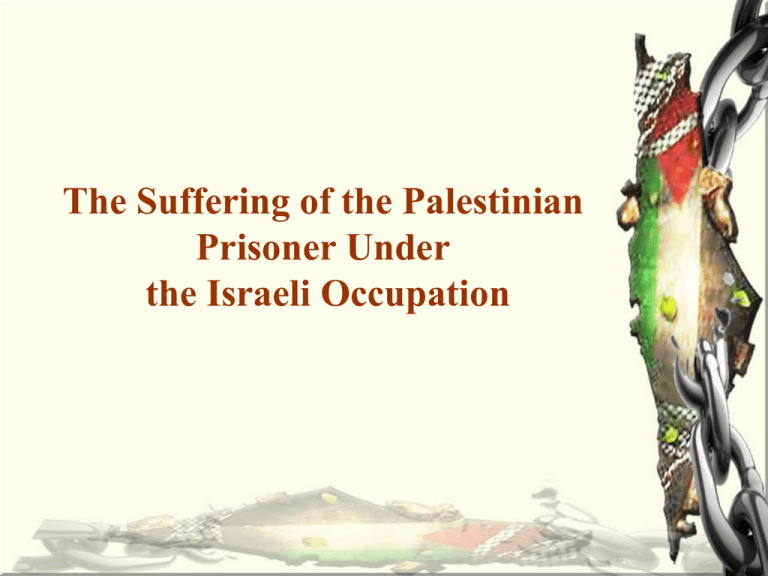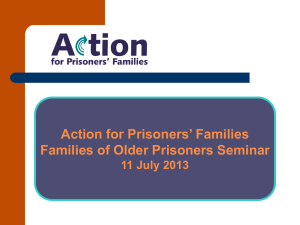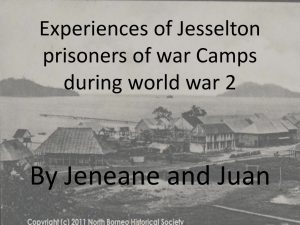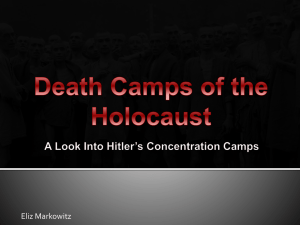
The Suffering of the Palestinian
Prisoner Under
the Israeli Occupation
First: Statistical and Informational
Background
•1967 until the end of 2009, 750 thousands
Palestinians were arrested.
•At the end of 2011, there are 4,315 Palestinians
prisoners:
- including 6 women &132 children.
- 3,856 are from WB.
-198 from East Jerusalem.
- 459 from GS.
•At the end of 2011, 307 Administrative detainees,
while in 2010 they were 219.
All are held in more than 20 prisons and detention
centers, the most significant ones being: Nafha,
Ramon, Beer Shiva, Ashkelon, Hadarim,
Shatta, Ramleh, Jelbou‘, Hasharon, Negev,
Megiddo and Ofer.
Palestinian captives include men, women, children,
patients, deputies and ministers, laborers, students,
mothers and housewives.
Second: Legal Background
The Universal Declaration of Human
Rights (1948)
1. No one shall be subjected to torture or to
cruel, inhuman or degrading treatment or
punishment (Article 5).
2. All are equal before the law and are entitled
without any discrimination to equal protection
of the law (Article 7).
3. No one shall be subjected to arbitrary arrest,
detention or exile (Article 9).
4. Everyone is entitled in full equality to a fair
and public hearing by an independent and
impartial tribunal, in the determination of his
rights and obligations and of any criminal
charge against him (Article 10).
5. Everyone charged with a penal offence has the
right to be presumed innocent until proved guilty
according to law (Article 11).
The rights of the prisoners and the way they
should be treated in addition to criminalization
of torture and arbitrary detention or the holding
of hostages, even in time of war, always
constituted an important subject for
international conventions, treaties and charters.
The Third Geneva Convention, 12/8/1949
•The Convention address the conditions of the
prisoners, the state of the facilities, the conditions of
the food, medical care, protection, services,
and the physical and mental activities of the
prisoners.
•It takes into account specific cases of prisoners
such as women, children, clergymen and those with
military ranks.
• It talks also about the prisoners' visits and
correspondences, their earnings, relations with the
outside world and their trials.
• It is applied to the members of the military or armed
groups who fall in captivity.
• It stipulates that they have the right to humane
treatment.
• The right to communicate with their relatives
and the International Red Cross.
• The right to receive letters and packages.
• The right to keep their clothes, their own eating
utensils and their personal effects.
• The right to be provided with adequate quantities
of food & clothing.
• The right to receive the necessary medical care
according to their health status.
• The right to be paid for any work they have to do.
• The right to be released immediately after the end of
the hostilities or the conflict.
States holding captives as Prisoners of War
should not:
• Force them to provide any information other than their
names, ages, their ranks and service number.
• Deprive them of their precious belongings or money
(except temporarily and after providing them
with a detailed receipt).
•Distinguish between prisoners on any basis except health,
sex, age, military rank or professional qualifications.
• Force them to carry out military actions or acts that
are dangerous or degrading or harmful to health.
Article 3 of the Convention prevents, at all
times and places:
•Taking hostages or aggression on liberties and
physical integrity. It also prevents torture, cruel
treatment, assault on personal dignity.
• The issuance of sentences or execution of statements
without a trial before a legal court that should ensure
all the necessary judicial guarantees for those who
have not directly participated in the hostilities. This
should include, among others, members of the armed
forces who have laid down their weapons, and the
disabled who could not kill because of illness, detention
or any other reason.
The Convention adds that even those who have taken
part in the hostilities must in their trial be submitted
to the laws and regulations of the armed forces in the
state that holds them, taking into account the different
levels of loyalty and ranks while securing the generally
accepted guarantees of independence and impartiality.
In addition, the prisoner has the right to have a defense
lawyer, to call witnesses and be notified-together with
his lawyer-of the charge sheet a reasonable time before
his trial.
The Convention prohibits applying collective for
punishments individual acts, corporal penalties, the
imprisonment in facilities without daylight, and, in
general, the infliction of any kind of torture or cruelty.
The Convention against Torture and other Cruel,
Inhuman or Degrading Treatment or Punishment
(1984) does not allow any justification for torture
on the grounds of exceptional circumstances, even
in the case of war, threat of war, state of
emergency or threat to internal stability; nor in
the pretext of administrative orders issued by
a public authority or employees of higher rank.
With regard to the conditions and environment of
imprisonment, a set of criteria that forms the
Standard Minimum Rules for the Treatment of
Prisoners was identified in the UN Document
A/CONF/611 adopted on 30/8/1955, so that all
member states should make every effort to ensure
its application.
The first paragraph of the Document includes
general rights as the principle of nondiscrimination and the need to respect the
prisoners' opinions and their political beliefs.
Regarding accommodation, the Document
stipulates that conditions should be taken into
consideration:
•The facilities’ amount of air, floor space, heating,
lighting, ventilation and windows.
• Health conditions, such as those related to
cleanliness, adequate number of private toilets and
Showers.
• The requirements of good appearance and
personal hygiene.
• Appropriate, clean clothing for the prisoners
as well as bed linen.
•The need to provide drinking water and adequate, healthy
food at usual meal times.
•The necessity to allow the prisoners to be exposed to fresh
air at least an hour daily.
•To provide medical care for them and transfer the patients
who need special medical care to equipped facilities or
civilian hospitals.
•To provide pre-and post-natal requirements in women's
places of detention.
•In addition to articles concerned with discipline and internal
penal codes of the prisons, visits and communication with the
outside world, the right of the detainees to pursue their studies
and have access to books, news and the latest updates.
Third: Detention, Trial and Conditions
of Captivity
Since its beginnings, the detention process has witnessed
many violations against the Palestinian prisoners:
• They are seized according to a set of military
commands, or randomly without any arrest warrant or
justifications.
•In most cases, the captives are not accused of a
specific charge.
• They are interrogated and tortured so that they
confess—under persecution and pressure—to what they
have not committed.
• In case they are tried, the prosecution takes place in
military courts that are headed by one or three Israeli
judges appointed by the military.
1. Arbitrary Arrest
Usually all arrests are done:
• Without prior warning.
• Without clear reasons for the arrest.
• In most cases, apprehensions are accompanied by
house raids and naked inspection.
• Pressure is exerted on the detainees through their
family members such as wives and children.
• At midnight or shortly before dawn, in order to cause
the highest sense of terror and intimidation possible.
• Hundreds of detainees are kept in custody for a long
period of time without bringing them to trial and
without any charges. However, the authorities might
release them later without interrogation or even
compensation for the arbitrary arrest.
a. Special Laws of Arrest and “Legal” Violations
The Israeli military order number 1500 (2002):
permits the army to hold a detainee for a period
of 18 days without meeting with an attorney.
Most of the times, the captives are either transferred
to arbitrary administrative detention which might be
indefinitely renewed, or left to wait for a trial which
may or may not come.
According to the Israeli laws pertaining to
Palestinians, the duration of detention awaiting
prosecution might be extended to 180 days.
Furthermore, the military order number 1530
limited the duration of trial to two years, where
previously it was open-ended and non specific.
In mid 2008, Israel continued it use of the law
of “illegal combatant,” which entitles the
authorities to overcome any custom or law
when they perceive of a prisoner as an illegal
fighter. Thus, they could hold him for
indefinite time and without trial.
•According to Addameer Association, any Israeli
military judge could detain a Palestinian without trial
for 90 days, and this period could be extended three
more months by virtue of an order from the Israeli
judicial counselor a military judge. Palestinian
prisoners could be prevented from meeting with their
lawyers for 60 days since the day of arrest.
•The Israeli law does not permit the detention
of an Israeli citizen for more than 24 hours without
bringing him or her before a judge. It forbids the
detention of an Israeli citizen without a charge
for more than 15 days that could be extended 15 more
days only; and In addition, the duration of prevention
of meeting a lawyer should not exceed 15 days.
b. Administrative Detention
•Administrative detention is considered as a
blatant example of random detention.
•A person is held for a renewable period of
six months without being charged or brought
before a court of law.
•The minister of defense can use administrative
detention without reference to the judiciary.
•The military leaders can issue arrest warrants up to
96 hours before being confirmed by the commander
of the region.
•The military resolutions have permitted an
indefinite period of arrest by allowing extension for
additional six months upon the completion
of the first arrest period.
•The Israeli authorities have regularly
resorted to the renewal of the period of
administrative detention for one year instead
of six months.
• Walid Khaled Harb was kept 67 months in
administrative detention.
•During al-Aqsa Intifadah, the number of
administrative detentions increased from 34
in 2001 to more than 960 during 2002.
•Since then, administrative detentions continued
with an average of 1,000 to 1,500 detainees
annually.
•The number of warrants were 2,850 in 2006.
•In 2007, warrants amounted to 3,101 including
detentions or extensions of detentions even of
deputies or former ministers. In 2008 amounted to
2000, and in 2009 it reached 1,200.
•Since the outbreak of al-Aqsa Intifadah in 2000 and
until 21/11/2009 has reached 19 thousand decisions.
2. The Trial
•Before the trial, the captive is severely persecuted in
the basements of interrogation where he is charged
with many accusations, on the basis of a list
prepared in advance by the Israeli Intelligence.
•In case the captive does not confess, he would be
informed of the administrative detention. Otherwise,
he or she would be given the option to confess to
some charges and a shorter sentence, or have the court
approve all the charges and try him or her on this basis.
•A captive might be given the choice between
extradition and the incarceration the Israeli prisons.
•Furthermore, there always remains the pretext
of the “secret file” and “security reasons,”
which the occupation authorities employ at any
time for administrative detention that could be
extended for an unlimited number of times.
•Sometimes, some prisoners who have
completed their sentences are transferred
to administrative detention.
•Saleh al-‘Arouri completed his five year term
of imprisonment to be transferred to administrative
detention. Then, he was tried once again on the basis
of new charges and again transferred to administrative
detention to spend a total of 15 years in prison,
and bereleased on 11/3/2007. However, just after
three months of release, -‘Arouri was arrested and put
again under administrative detention.
•Lawyers face lots of difficulties in this respect:
- Visiting or entering prisons.
- The small number of lawyers available to defend
the increasing number of Palestinian detainees.
- Arbitrariness of the Israeli military laws
and legal procedures.
- In most cases, the lawyers are not notified
of the date of the sessions.
- Confessions extracted under coercion by torture
and the secret files, on which the court depends
or even fabricates, thus making the task of defending
the captives or refuting the accusations futile.
3. Conditions of Captivity
a. Facilities and Rooms
•There are more than 20 prisons and detention
centers.
•Most if not all of those buildings lack the
humanitarian conditions necessary for
detention. The buildings are incompatible
with international criteria regarding captivity.
The following points reveal such infringements:
• Holding of detainees in areas other than those
where they have been arrested, mostly outside
the territories of self-government.
• Specifications of buildings, where the rooms
are small and crowded, poorly painted and
humid with dirty and rotten walls; and the
lack of proper ventilation as the windows are
closed with iron plates.
• Serious, and sometimes deliberate lack of
services and essential equipment in rooms such
as toilets and showers, or in prisons such as recreation
yards (arenas for prisoners where they could be
exposed to the sun and to exercise); access to those
services is so restricted to the extent that the prison
administration requires the prisoners to use the toilets
at specific times only!
•In Damoun Prison, the bath place and toilet are one—
a mere hole in the ground emitting foul smells and is
dramatically surrounded by insects, which have caused
many skin diseases for the detainees.
• Presence of insects, cockroaches, rats and
sometimes scorpions in the prisoners' sleeping
quarters and among their stuff. Snakes are found in
the Negev desert prison.
• Difficult weather conditions like the scorching
heat in the Negev desert prison. Moreover, the
occupation authorities sometimes deliberately create
abnormal climatic conditions as the extremely hot or
cold chambers, to intensify the suffering of the
prisoners. The sudden change of temperature
through air-conditioning (extreme heat followed by
severe cold) is also used as a means of torture
against the prisoners.
b. Health Conditions and Medical Negligence
• The food provided to the prisoners is poor in quality
and quantity, The case with drinking water is as bad as
with food. Most of the time, water is not available, and
when it is there, it is usually impure. Prisoners in
Damoun center affirm that the color of water served to
them is closer to that of milk, so they have to filter it by
putting a piece of cloth on the opening of the tap. What
they get after they remove the cloth is a handful of sand,
gravels and rust.
• Lack of hygiene and prevention of bathing for long
periods of time.
• The drastic shortage of clothes and blankets,
prisoners are not provided with the toiletries
necessary for cleanliness.
• Deprivation of sleep, which results from the
harsh conditions in the prison cell, or due to
the nonstop interrogation that might proceed
for more than 20 hours.
• Deprivation of necessary treatment, medical
negligence and supplying the patients only
with palliatives (mostly Acamol).
Usually, the following diseases spread widely
among prisoners:
•Chest infections, inflammations and discomfort.
•Skin diseases.
•Eye diseases.
•Stomach ulcers, hemorrhoids and abdominal
swelling.
•Winter related diseases.
•Chronic diseases resulting from neglecting the
injuries caused by gunshots upon arrest.
•Diseases and illnesses that ensue from torture
and repressive practices such as asthma and
lung diseases.
•Psychological and neurological diseases.
•Israel also does not hesitate to adopt medical
neglect as a policy against the prisoners:
-Ramleh Prison Hospital shares the main characteristics
of prisons and other detention centers. Only few
prisoner patients could have access to this hospital
albeit after deliberate procrastination and neglect.
- When a patient is brought from another prison
for a surgery and there is no low bed available, he is
made to choose among the bunk bed, sleeping on the
floor, or, worst of all, signing on the postponement of the
surgery to a further date that might or might not come.
-Ill prisoners are taken to courts with their hands
and legs in shackles. Instead of transporting
them in ambulance cars, they are transferred in
unventilated vehicles in a trip that takes two to
three days. They usually come back loaded
with new diseases due to the bad conditions
they had been through. Doctors from outside
the hospital are not allowed to enter except
rarely.
-There are about 1200 prisoners who are treated
in Ramleh Prison Hospital, where 60 are
permanent residents.
- One of these prisoners is Mansur Mawqedi from
al-Zawiya in Salfit. Upon his arrest, Mawqedi
was shot three bullets in his stomach; thus, the
lower part of his body was paralyzed and most
of his digestive system was replaced as a result
with a plastic one (one sac for urine and another
for stool, plastic stomach and intestines, and he
has to move on a wheelchair).
Following is a summary of the most significant
forms of medical neglect and poor health care,
• Shortage of the quantity of medicine and its
poor quality.
• Procrastination in providing prisoners with
treatment, delay in transferring urgent cases
to hospitals.
• Requiring the prisoners' families to pay the
costs of treatment.
• Lack of resident doctors or specialized clinics
in the detention centers.
• Abusing the prisoners, searching their rooms
and beating them on hospital beds and during
their transport from the prison to hospital.
• Bargaining the prisoners to give confessions
in order to get treatment.
c. Isolation from the External World
•Israel is adamant to exploit the psychological
and emotional side of the Palestinians to the
Extreme.
• It tries to isolate them as much as possible from
the external world, particularly their families
and lawyers.
d. Other Rights and Violations
• Depriving the prisoners from their right to
complete their education.
• The prisoners are deprived of their rights to practice
their religious rites.
• Israeli officers conduct provocative inspections
of the cells and they confiscate the prisoners’
belongings.
• The transfer to another prison or to the court
the "trip to death.
• The prisoners are subjected to naked inspection
when they request going out to meet the lawyer
or their family, or to go to the clinic and even
to the court.
Fourth: Torture
•Torture was legalized after the “Landau
Commission,” chaired by Moshe Landau the former
chief of the Supreme Court of Israel, has legalized
torture in 1987, declaring that “the prevailing view is
that recourse to some measure of physical pressure in
the interrogation of HTA [hostile terrorist activity]
suspects is unavoidable.”
• The Landau Commission recommended that
the ISA should be authorized to use psychological
pressure and “a moderate measure of physical
Pressure” in their interrogation of “security”
detainees.
•The decision of Landau Commission has marked
the beginning of a package of military orders that
allowed torture of the prisoners, especially in the
period 1993–1999.
•Those decisions, along with the Israeli public wide
approval, caused an increase in the prevalence of
torture in Israeli prisons in the above-mentioned
period.
The following are the most prominent torture
methods:
1. Sexual harassment and the threat of rape.
2. Severe beating with hands, feet and rifle butts.
3. Forcing them to strip naked.
4. Forcing them to mimic animal voices and
movements as a form of humiliation.
6. Forcing them to stand in the open air in
summer and winter for long hours.
7. Stamping on them after their arrest.
8. Obscene and degrading insults.
9. Exposing them to severe shaking.
10. Shabeh (a position abuse), and forcing
them to stand in difficult positions or to squat
on their tiptoes (pressure position).
11. Extreme tightness of shackles.
12. Deprivation of sleep for long periods of
time.
13. Wrapping their heads with a filthy cover.
14. Forcing them to listen to boisterous music.
15. Subjecting captives to psychological pressure,
by making them believe that they are allowed
to speak to a lawyer, then preventing the lawyer
from meeting with his client for security reasons.
16. Planting undercover agents in detention rooms
and blackmailing the prisoners through
different methods, in the so-called “birds rooms.”
17. Extinguishing cigarettes on their bodies.
18. Preventing the use of the bathroom for long
periods of time.
19. The threat to pass military resolutions authorizing
the torture of the detainee to death or the
demolition of the family house among other
means of threat, as a form of psychological
pressure on the detainee.
20. Exposing the prisoner to electric shocks until loss
of consciousness.
Fifth: Female Captives in Israeli Prisons
Rough statistics show that since the onset of the
Occupation and until April 2011, Israel has detained
around more than 12 thousand Palestinian women,
including mothers, minors and old-aged, and
including 850 women during al-Aqsa Intifadah
(2000).
At the end of 2011, there are 6 female prisoners.
The conditions of their arrest and treatment,
however are wrapped with the same cruelty that
governs the conditions of the other prisoners.
Furthermore in this respect, we should add the
following particularities related to women:
• Staying away from their children, husbands
and homes; and thus losing the sense of
maternity as a result of forcibly being away
from their children.
• Prevention of family visits to female
prisoners, or the complication of such
procedures.
•Depriving female prisoners of any direct
contact with their children who are more than six
years old, and allowing the visits and communications
only in the presence of barriers.
• Preventing female prisoners from visiting
their detained husbands; thus lots of families
can not meet for long years, a contradiction
to the stipulation of Article 82 of the Fourth
Geneva Convention.
• The naked inspection of women prisoners
upon the visit of their families, or the visit of
the husband to the court.
•Abuse of the dignity and honor of female
prisoners through obscene insults and harassment,
and the sudden breaking into their rooms by
male jailers.
• The presence of Jewish criminal prisoners in
sections close to those of the Palestinian
political prisoners, which leads to continuous
violations committed by the Jewish criminals
against the women captives.
Sixth: Children Captives in Israeli Prisons
•Contrary to the provisions of Article one of the
Convention on the Rights of the Child which
defines the child as “every human being below
the age of 18,” the Israeli Military Order no.
132 considers the Palestinian child who is
over 16 years of age as an adult.
•Since 1967, Israel has adopted the policy of
arresting children as a means of pressure against the
Palestinian freedom fighters.
•According to WAFA , in 14/4/2011, the number
of child prisoners since al-Aqsa Intifadah reached
8000, where 245 were still prisoners.
• At the end of 2011, after the prisoners deal,
there were still 132 children prisoners.
•In contrast to the stipulations of the Convention
on the Rights of the Child regarding the
necessity to treat children prisoners in a way that
considers their age and needs there is no
segregation between adults and minors, or
Palestinian minors and Israeli criminal minors.
•Suffering becomes worse when children
prisoners are exposed to the practices and
insults practiced against adults.
• Despite the 1997 Israeli resolution that
recognized the Palestinian child
prisoners’ right to education. Yet, Israeli
prisons’ administration still denies the
children's right to education through the
confiscation of books and the restrictions
on access to education.
Perhaps the worst thing in the suffering of
children prisoners is not what has been
mentioned above, but rather its everlasting
repercussions that impact them all through
their lives, after they are released from
captivity. Life of the prisoners is subject to
collapse and psychological destruction due
to the procedures pursued against them
during detention.
Seventh: Families of the Prisoners: Denial
of Visits and Deliberate Targeting
•The Israeli authorities use the prisoners' families
to coerce the prisoners, especially through women
such as mothers and wives, or children and the aged.
The Public Committee against Torture in Israel
(PCATI) published in early 2008 a report entitled:
“Family Matters: Using Family Members to
Pressure Detainees under GSS Interrogations.” The
report cited six detailed cases where the families of
the suspects were used during interrogation, in an
unacceptable manner; sometimes by ungrounded
detention or by torture to intimidate the prisoners
during interrogation.
•One of the most poignant cases mentioned in
the report concerns “a detained couple held for
an extended period of time, subjected to severe
physical torture, and, in addition, refused knowledge
of the fate of their young daughters, aged two and a
half and 6 months, who were used as bargaining
chips by the GSS.”
•Another prisoner said that the interrogator told him
that his father was arrested, and that they would kill
[his] mother, arrest [his] 18 year old sister and rape
her, and destroy [their] house if he would not
cooperate.
Eighth: Palestinian Prisoners and Swap Operations
•On 23/7/1968, there was a swap deal after fighters
from the Popular Front for the Liberation of Palestine
had hijacked an Israeli plane heading from Rome
to Tel Aviv, with more than hundred passengers on
board.
The deal was sealed via the ICRC where 37
Palestinian prisoners serving high sentences
were released.
•The most prominent deal, however, was
conducted on 23/11/1983 between Fatah and
the occupation authorities where Israel had to
release all the 4,700 captives in Ansar Detention
Camp in south Lebanon (this camp was destroyed
by the occupation forces shortly before the Israeli
withdrawal from Lebanon in 2000),
besides 65 prisoners in Israeli jails; in exchange
for Fatah's release of six Israeli soldiers whom it
had captured in the Lebanese town of Bhamdoon
during the Israeli invasion of Lebanon.
• Three Palestinian factions (Hamas, Brigades of
Saladin and the Army of Islam) have succeeded
in the capture of the Israeli Corporal Gilad
Shalit on 25/6/2006.
• On 2/10/2009, 18 female prisoners from the
West Bank and one from the Gaza Strip along
with her son, were freed in exchange for a
video tape of Gilad Shalit proving that he is
still alive.
• The Egyptian and German intermediaries
failed to broker any deal concerning Shalit,
since these two were generally biased
towards Israel.
• At the end of March 2011, Musa Abu Marzuq
announced that Hamas would no longer accept
the German side as an intermediary.
• In August 2011, new round of talks began,
when Israel’s Defense Ministry Political-Security
Bureau Director Amos Gilad discussed Shalit’s
case with the Egyptian officials.
• Hamas political bureau delegate, Ahmad
al-Ja‘bari, led the Palestinian negotiation team,
while David Meidan led the Israeli one.
Egyptian intelligence officials have been
mediating between the two parties.
• On 11/10/2011, Khalid Mish‘al announced
that a deal has been reached, “Devotion of the Free”
Deal, where 1027 Palestinian prisoner would
be exchanged for the Israeli soldier Shalit, and that
the agreement was of two stages.
• First Stage (18/10/2011): 477 prisoners
released (450 males & 27 females).
• Details:
a. 6 from 1948 Palestine.
b. 318 from the West Bank (45 from East
Jerusalem).
c. 125 from Gaza Strip.
d. 1 from the Golan Heights
e. Of those, 315 male prisoners & 5 female were
serving life-sentences.
• Second Stage (18/12/2011): 550 prisoners
released (most of them of the Fatah
Movement). They included 6 females and
55 minors.
• Details:
a. 507 from the West Bank (2 from East
Jerusalem).
b. 41 from Gaza Strip.
c. 2 from Jordan.
Hunger Strikes
• In late September 2011, Palestinian prisoners
began a hunger strike to protest the punitive
measures taken against them.
•It was suspended simultaneously with Prisoner
swap of 18/10/2011, and after the Israeli prison
authorities agreed to some of their demands.
• On 17/12/2011, Khodr ‘Adnan began a hunger
strike immediately after his administrative
detention. His 66 days of strike ended on
21/2/2012 and was released on 17/4/2012.
• On 16/2/2012, Hana’ Shalabi was arrested
after her release in the “Devotion of the Free”
deal. She began a hunger strike that lasted 44
days, and was ended by forging a deal with
Israelis. On 1/4/2012, she was deported to
Gaza Strip, where she would stay for three
years.
• On 17/4/2012, about 1,300 Palestinian
prisoners began an open-ended hunger
strike, dubbed the war of empty stomachs
or Karamah (Dignity) hunger strike. Some
prisoners have been on lengthier hunger
strikes like Tha’er Halalhah and Bilal Diab,
(since 28/2/2011).
The prisoners demands include:
a. An end to the policy of solitary confinement
and isolation.
b. Ending Administrative Detention.
c. To allow the families of prisoners from the
Gaza Strip to visit prisoners.
d. An improvement in the living conditions
of prisoners and an end to the ‘Shalit’ law.
e. An end to the policies of humiliation
which are suffered by prisoners and their
families such as strip searches, nightly raids,
and collective punishment.
On 14/5/2012, Palestinian prisoners in Israeli jails
agreed to an Egyptian-brokered deal aimed at ending
their mass hunger strike.(1600 prisoners)
• Israel agreed to end solitary confinement.
•Lifting the ban on visits to prisoners by first-degree
relatives living in the Gaza Strip.
•Freeing the administrative detainees once the complete
their terms unless they are brought to court.
•The prisoners signed a commitment not to engage in
actions contravening security in jails.









